|
May 27, 2022
Dear Neighbors and Friends,
I hope that you and your loved ones are doing well, staying healthy, and looking out for your neighbors and friends during this past week.
In tonight’s newsletter you’ll find details about next week’s quarterly Legislative Days, an opportunity for us to catch up on what’s happening all across state government, legislative action, and budgeting. You’ll find the schedule and links to each of the committee hearings, which you’ll be able to follow as they’re occurring and after.
It will soon be time for another SD 23 Constituent Coffee. You’ll find more on that below.
And as we enter the Memorial Day Weekend, a time for appreciations and memories, a time to hug loved ones tightly, our flags are sadly flying at half mast today. Yet another senseless, horrific, act of gun violence has struck our nation. More below on what we must do to address these actions after the initial period of sympathy and prayer.
On the COVID front, we’re continuing to experience a surge in new COVID infections, test positivity rates, and hospitalizations. Fortunately, most (though not all) of these infections are relatively mild, thanks to the effects of Oregon’s high levels of COVID vaccinations. Hospitalizations appear to be increasing at levels somewhat faster than predicted in the recent OHSU forecasts, but this is largely the result of higher COVID rates in the population at large. Many if not most of these so-called COVID hospitalizations are due to infections detected in patients admitted for other reasons.
As you’ll see in the data and graphs below, the number of Oregonians in the ICU for COVID has actually been going down. The same is true of reported COVID deaths. This is incredibly good news.
Some of this is due to the current dominant form of COVID being milder (though more infectious) than earlier versions. Some is due to the benefits of vaccines. And some is due to more effective treatments, notably easier access to the antiviral drug Paxlovid. More on that in the articles linked below.
In those linked articles you’ll also find the latest on vaccines for children under the age of five and the latest on what we’re coming to learn about “Long COVID.”
You’ll find details on all of these developments in this newsletter, along with the links and graphs that will clarify the current status of the pandemic for you.
Until the next newsletter, please stay healthy and safe. And let me know if you have any questions or thoughts about anything in tonight’s newsletter.
COMING A WEEK FROM SATURDAY: June Constituent Coffee!!!
Saturday, June 4, is the first Saturday of the month, which means another monthly constituent coffee from 9 am to 10:30 am. We’ll be returning to Zoom for this meeting. (I’m alternating between in-person and remote for now.)
It will be a chance for me to report on highlights of the upcoming committee hearings, on various work groups, let you know about bills likely to come our way in 2023, get your thoughts on priorities and future action.
You can register for the June 4 coffee here. Hope to see you there!
Addressing the Horrors of Gun Violence: What We Can Do Together
Like many of you, I’ve spent the last few days in a state of shock and horror over the senseless massacre of young children and teachers in Uvalde and the racist murders in Buffalo just days before. Like many of you, I’ve been filled with a mixture of grief, outrage, and determination to do what I can to reduce the violence caused by individuals wielding deadly firearms.
I’ve heard from many of you, expressing your frustration with the lack of progress at the national level to this problem. Clearly, we ultimately need a coordinated national approach. But that doesn’t mean that there aren’t important steps that we as a state can take. If enough of us do, it will make it easier for our federal delegation to convince their congressional colleagues to step up and do what most Americans want them to do.
As I’m sure most of you know, the Oregon Legislature has in fact taken a leading role in passing cutting-edge legislation on background checks, domestic violence prohibitions, safety research, safe storage, extreme risk protective orders (so-called “Red Flag” avenues to limit possession), as well as prohibitions on guns in schools and other public buildings. We must and will continue to do so next session. I know that we will be looking at legislation prohibiting gun purchases for those under the age of 21, along with action to prevent the possession of so-called “ghost guns” and those created via 3-D printing.
Here's a link to a list of what we've done and what is yet to be done.
But this is not entirely the responsibility of the Legislature. Oregon is a state where measures can be put on the ballot through the initiative process, and their passage sends a powerful message to the world at large. There’s one out there now that I’d ask you to support.
A coalition of faith leaders is working hard to get Initiative Petition 17--The Reduction of Gun Violence Act--on the ballot here in Oregon? It would do two important things: limit the ammunition capacity of firearms magazines and require a permit to purchase a firearm. Both of these strategies have been shown to be very effective in limiting gun violence.
Here's info about that effort, called Lift Every Voice. You can help with the signature-gathering, as well as supporting it in other ways. You can even print out and sign a petition directly from your home. This is not a well-funded effort by any means, so every kind of action will be crucial to its success.
Both elements of this ballot are crucial to containing gun violence. Getting this passed would be a strong signal from Oregonians to the nation that more action is needed. It would send a clear message to the Legislature that Oregonians want real change right away and would also send a strong signal to the nation as a whole.
Please do stay active on this issue. It's the only way we can move beyond the debilitating despair that the events of the last week have provoked in so many of us.
Coming Up Next Week: Another Round of “Legislative Days”
During the interim months between legislative sessions, the Oregon Legislature has made it a practice to schedule a week each quarter for committees to meet, receive updates on implementation of policies passed during the session, and hear about topical issues and problems that will need addressing. It’s also a time for the Senate to meet in chamber to confirm (or not) the Governor’s executive appointments and appointments to various boards and commissions. Typically, the Ways and Means Emergency Board (EBoard) will also meet to appropriate funds as needed.
Aside from the Senate confirmations (which require senators to be present in person), the committees will again be meeting remotely via Microsoft Teams. This is due mainly to the fact that the Capitol is still being renovated (there won’t be space available for in-person committee meetings until the end of the year), but it also makes sense given the current surge in COVID cases that is projected to last till the end of June.
Typically during Legislative Days, the agenda items are addressed through invited testimony from agencies, experts, and advocates. However, the meetings are of course always open to the public via audio and video, and they’re always recorded. All the meeting materials are available on the meeting webpage.
Here's the Calendar of Committee Hearings
AND BELOW IS THE SCHEDULE of committees, task forces, and commissions, with links to the meeting webpages:
Tuesday, May 30
Commission on Transparency Oregon Commission: 9:30-11:00 a.m.
Task Force on Efficient, Resilient Buildings: 3:00-5:00 p.m.
Joint Task Force on Student Success in Higher Education: 5:00-6:30 p.m.
Wednesday, June 1
Senate Judiciary: 8:30-11:00 a.m.
Senate Labor and Business: 8:30-11: a.m.
House Economic Recovery and Development: 8:30-11:00 a.m.
House Housing: 8:30-11:00
House Business and Labor:11:30 a.m.-2:00 p.m.
House Early Childhood: 11:30 a.m.-2:00 p.m.
House Environment and Natural Resources: 11:30 a.m.-2:00 p.m.
Emergency Board Subcommittee on Education: 11:30 a.m.-2:00 p.m.
Emergency Board Subcommittee on Higher Education: 11:30 a.m.-2:00 p.m.
Senate Rules and Executive Appointments: 2:30-5:00 p.m.
House Agriculture, Land Use, and Water: 2:30-5:00 p.m.
House Health Care: 2:30-5:00.
Joint Gambling Regulation: 2:30-5:00 p.m.
Emergency Board Subcommittee on General Government: 2:30-5:00 p.m.
Thursday, June 2
Senate Energy and Environment: 8:30-11:00 a.m.
Senate Health Care:8:30-11:00 a.m.
House Behavioral Health: 8:30-11:00 a.m.
Joint Legislative Audits: 8:30-11:00 a.m.
Senate Natural Resources and Wildfire Recovery:11:30-2:00 p.m.
House Human Services: 11:30 a.m.-2:00 p.m.
House Revenue: 11:30 a.m.-2:00 p.m.
House Veterans and Emergency Services: 11:30 a.m.-2:00 p.m.
Senate and House Committees on Education, meeting jointly, 2:30-5:00 p.m.
Senate Finance and Revenue: 2:30-5:00 p.m.
Senate Housing and Development: 2:30-5:00 p.m.
House Wildfire Recovery: 2:30-5:00 p.m.
Friday, June 3
Senate Committee on Human Services, Mental Health and Recovery:8:30-11:00 a.m.
House COVID-19 Response: 8:30-11:00 a.m.
House Judiciary: 11:30 a.m.-2:00 p.m.
Joint Transportation: 8:30-11:00 a.m.
Joint Information Management and Technology: 1:00-3:30 p.m.
Emergency Board: 1:00-3:30 p.m.
ON THE COVID FRONT
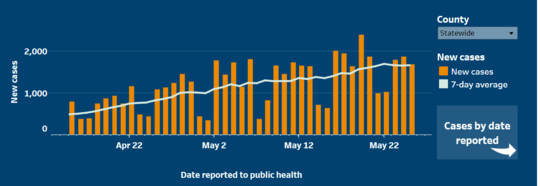
Weekly Report:
OHA didn’t produce a weekly report this week (they’re on an every-other-week cycle). We’ll get their next weekly update next Wednesday. In the meantime, here is some high-level information that can help let us know where we appear to be headed here in Oregon. At the end of the newsletter you’ll find graphs that I’ve put together showing the daily counts and trends for the last two weeks.
Overall, we see ongoing, more gradual increases in new cases and the number of new hospitalizations, ongoing increases in test positivity, reductions in COVID ICU cases, along with continued low rates of COVID deaths.
- The big week-over-week increases that we’ve been seeing recently are continuing to slow down. OHA reported 11,536 new cases of COVID-19 during the week of May 20-26 (vs. 10,251 the week before), a 7-day average of 1,648 per day. The number of new cases is again likely an undercount, as many people are using home tests to determine their infection status but are not reporting those results.
- On Thursday there were 307 COVID-19-related hospitalizations, vs. 226 last Thursday. We appear to be on track to hit the peak of 329 projected in the latest OHSU forecast ahead of the June 9th date forecast in the latest OHSU forecast report.. Again, many of these hospitalizations are not in and of themselves due to COVID—they include those who tested positive after having been admitted for other reasons.
- The number of COVID patients in Oregon’s ICUs is now 30, a decrease of 2 from last week’s 32. These are of course the individuals with the most serious cases.
- There were 30 reported COVID-19-related deaths during the last week, vs. 36 last week.
- Reported COVID-19 test results decreased from last week. There were 97,071 reported, vs. 100,631 last week. Again, this probably doesn’t count the majority of tests happening at home.
- Average test positivity for the last week was 12.3%, another large increase from the previous week’s 10.5%. Again, this number skews high because it likely reflects a higher proportion of people showing COVID symptoms (and thus going in for a test, rather than self-testing).
Weekly County Report: Twelve Counties Now at Medium Risk; Percent Positives Continue to Rise
OHA is no longer providing a weekly county report each Monday, but there are still ways to track this data. According to the CDC Daily Counter (updated each Thursday) 12 Oregon counties have reported infection rates that place them in the Medium Risk category: Benton, Clackamas, Crook, Columbia, Deschutes, Grant, Lane, Marion, Multnomah, Polk, Tillamook, and Washington (down from 14). The remaining 24 Oregon counties remain at Low Risk.
Again, we must remember that these are only the tests results that have been reported. With the prevalence of home tests, there are certainly many more positive cases out there that have not been reported.
Here’s what the CDC recommends for this category: Stay up to date with COVID-19 vaccines. Get tested if you have symptoms. Wear a mask if you have symptoms, a positive test, or exposure to someone with COVID-19. Wear a mask on public transportation. You may choose to wear a mask at any time as an additional precaution to protect yourself and others. If you are at high risk for severe illness, consider wearing a mask indoors in public and taking additional precautions.
We can also track the test positivity rates for each county and the state as a whole at this dashboard. The test positivity rates reported this week show continued increases.
Among the reported cases, the statewide infection rate has risen from 12.8% last week to 13.9% this week.
At 14.5%, Multnomah County is again above the state average, increasing from last week’s 14.0%. It is right at the Portland Tri-County average, which is also now 14.5% (up from last week’s 14.1%).
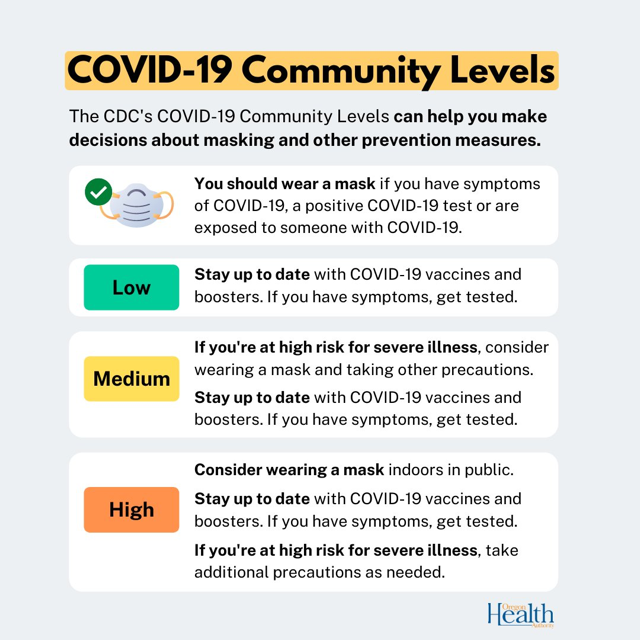
This Week’s Wastewater Monitoring Report Shows Reduction in Number of Cities with Steady COVID Increases
With testing reports giving us just a fraction of infections out there, wastewater monitoring has become a more reliable indicator of the amount of virus in cities around the state. That report is updated each week.
This week’s report shows us that the following cities are showing sustained increases: Canby, Newberg, Silverton, Klamath Falls and Ashland. (down from 8 last week).

From OHA: Advice from Dr. Cieslak
Here are some Q & A’s with Dr. Paul Cieslak, medical director for communicable diseases and immunizations at Oregon Health Authority, Just out from OHA:
|
Q: My child has had both of their COVID vaccines and it’s been five months since their last dose. They tested positive for COVID three month ago. Are they still eligible for a booster at this time? How long after a COVID infection should they wait to get a booster? – Summer, Beaverton
A: “Your child is eligible for a booster as long as their COVID-19 symptoms have subsided, and it’s been at least 10 days since those symptoms started, and it’s been at least five months since they received the last dose of the primary series. (If your child is immunocompromised, that waiting period is reduced to three months.) However, the immunity that your child got from having had COVID-19 is thought to protect them for at least 90 days afterwards, so you are safe waiting that long before having your child boosted.”
Q: Would it make sense to test for immune response levels before getting another vaccine dose? We understand over time immunity wanes with most vaccines. However, getting another booster (a fourth vaccine dose) in such a short time without sufficient evidence seems extreme. I think people would be much more on board with the regimen with personal proof of need. – Deena, Salem
A: “Unfortunately, at this point we don’t know what level of antibody – or what result of any other test that we might do -- proves that a person is immune. For that reason, the booster is recommended even for people who have antibodies. Some day we might learn how to find who is susceptible and who isn’t, but we’re not there yet.”
Q: Will the second booster vaccinations for COVID-19 be covered by insurance as were previous COVID-19 vaccinations? – Anonymous, Portland
A: “ Yes. Health insurance policies will cover the administration of all COVID-19 vaccines and boosters. Additionally, for uninsured people seeking a COVID-19 vaccine or booster, vaccinators may not turn them away or ask for payment.”
Q: I had a Johnson & Johnson shot in March 2021 and a Pfizer booster in November 2021. I felt a bit feverish and very fatigued the day after the Pfizer shot. For a second booster, would Pfizer or Moderna give me more protection from COVID? I am 85 so should probably get a second booster, right? – Ina May, Tigard
A: “Yes, everyone 50 years of age and older (like you and me!) is advised to get a second booster at least five months after the first booster (three months if you have a compromised immune system). Pfizer or Moderna is preferred because the Johnson & Johnson vaccine has led to more serious side effects, particularly blood clots.”
Q: Does a fever of 101+, chills and fatigue for two days after getting the second COVID-19 booster indicate it’s working, or is it a side effect to be worried about? – NG, Portland
A: “Those symptoms likely represent your immune system responding to the vaccine, which is a good thing! Those symptoms almost always subside after two to three days. If they persist, call your doctor or health care provider. If you don’t have a doctor or health care provider, call 211.”
|
|
Additional COVID Updates and Links
.
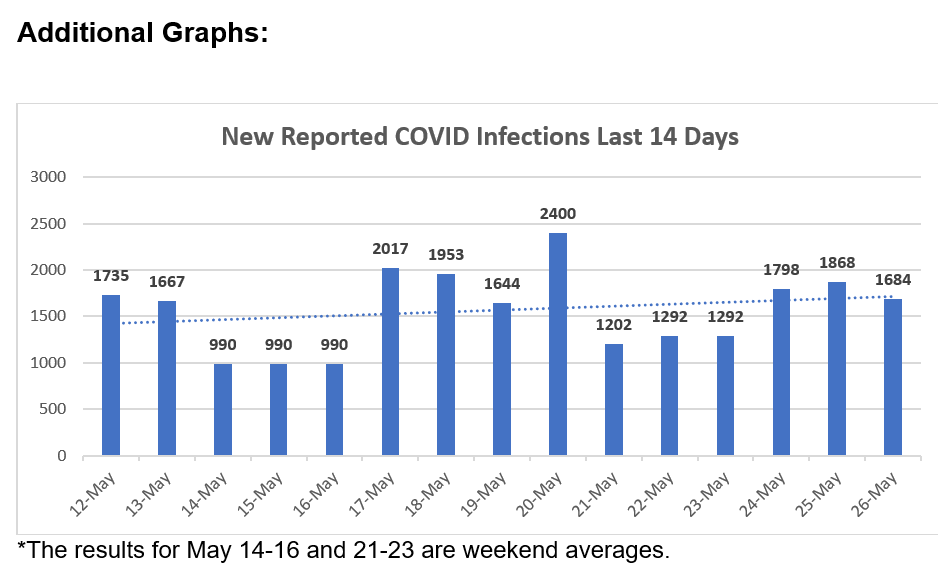
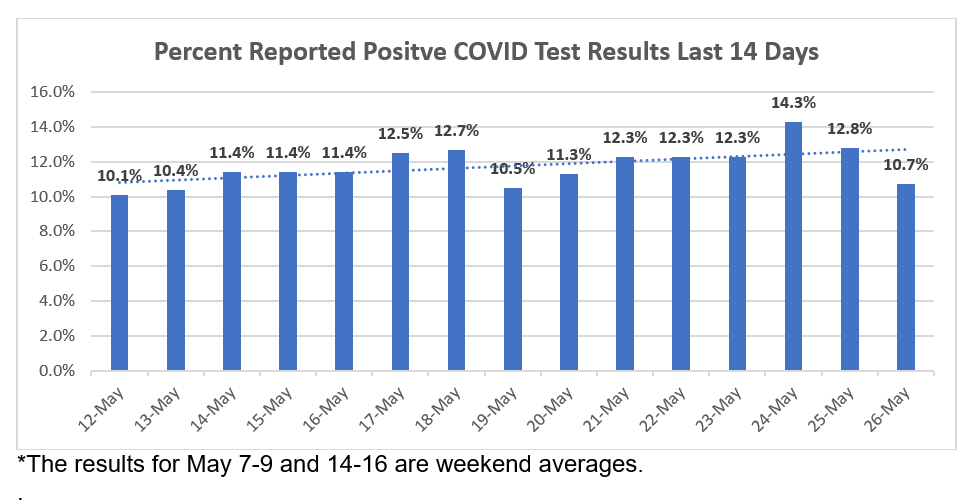
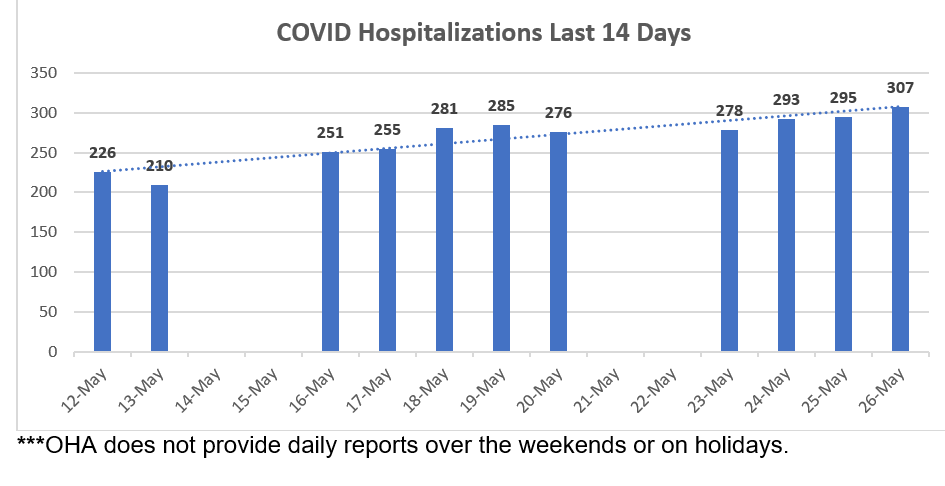
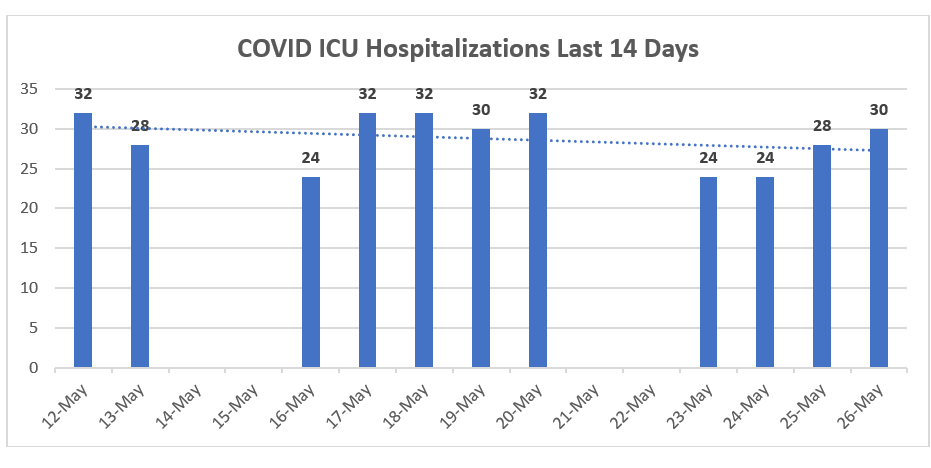
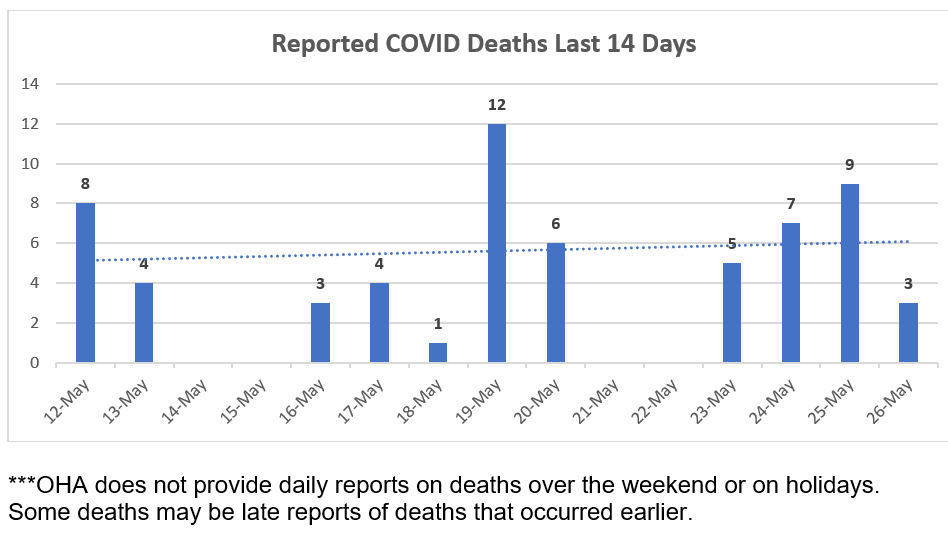
Here again are some COVID resources that you will find useful:
If the above links are not providing you with answers to your questions or directing you to the help that you need, please consider me and my office to be a resource. We’ll do our best to assist you or steer you in the right direction.
Want to See Past Newsletters?
If there was COVID-related information in a past newsletter that you want to go back to, but find you’ve deleted it, you can always go to my legislative website (senatordembrow.com), click on “News and Information,” and you’ll find them all there. Also, if someone forwarded you this newsletter and you’d like to get it directly, you can sign up for it there.
Best,
 Senator Michael Dembrow
District 23
email: Sen.MichaelDembrow@oregonlegislature.gov
web: www.senatordembrow.com
phone: 503-281-0608
mail: 900 Court St NE, S-407, Salem, OR, 97301
|